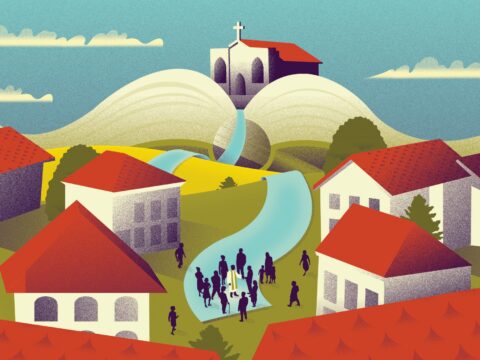God became feathers and lived among us. Mark I. Wallace, an author and theologian, likes to remind people that God showed up at Jesus’ baptism in the form of a dove. This isn’t just a metaphor, he says, but a blood-and-feathers incarnation of the divine.
“All of creation and its many inhabitants are God in a variety of forms and disguises,” Wallace writes in his 2019 book, When God Was a Bird. In it, he describes the Earth as “an animate being, a living soul, a spiritual life force” that, like humans, experiences sorrow and joy.
You may unsubscribe from any of our newsletters at any time.
Wallace, who teaches religious and environmental studies at Swarthmore College in Pennsylvania, calls himself a “Christian animist,” a term that some Christians will find oxymoronic if not outright heretical. Indeed, for centuries western Christianity has denounced, suppressed, outlawed and erased pagan and Indigenous belief systems that acknowledge animals, trees, stones, rivers and mountains as beings with living spirits.
But Wallace believes there’s an animistic understanding of the world deep within Christianity — and that it’s vital we recover it now. An anthropocentric Christianity has helped create the conditions for our planetary ecological crisis. Only once we recognize the spirit of God in wood thrushes and great blue herons, says Wallace, will we be able to respond appropriately.
More on Broadview: Anti-pipeline activists on standing in oil’s way
Wallace grew up in Los Angeles in a “broad-minded” Presbyterian family. He attended church but didn’t feel a deep emotional connection to Christianity. When he was a teenager, a friend took him to see Billy Graham preach in a baseball stadium. Wallace was transfixed. When he told his mother that he’d become a Christian, she said, “What do you mean? You’ve always been a Christian.” Today, he describes himself as someone who feels the tension between his “liberal Christian head” and his “warm evangelical heart.”
“I love the Bible and read it constantly,” he says. But as he worked his way through seminary and a PhD in theology at the University of Chicago, he began to read the Bible very differently than he had growing up.
“The Bible is a record of a pastoral nomadic people who lived close to the land and found God within every rock, every tree, every animal they encountered,” he says. For instance, Jesus performed a “shamanic healing ritual” when he smeared clay made with his own spit on a blind man’s eyes. Wallace also points to biblical scenes where God assumes not just human flesh, but also the body of a dove, the leaves of a burning bush or the form of a snake on a pole that people turn to for healing.
“God emptied God-self into everything that is, every plant, tree, rock and body of water. That’s the great teaching of a Christian faith that now re-understands its rootedness in the animistic soil of Indigenous people,” Wallace says.
If God’s spirit animates the world around us, what does it mean, theologically speaking, that species are going extinct at record rates?
While speaking on the phone for this story, Wallace falls suddenly silent, enthralled by the sight of a Cooper’s hawk alighting on a treetop outside his window. When he recovers himself, he begins to speak sorrowfully about the decline in birds, due to habitat loss, that he’s witnessed in recent years in the forest surrounding his Pennsylvania home. “I’m trying to live with my sense of wonder and also my rage. That’s not a contradiction of faith. It’s faith itself that juxtaposes those emotions that can’t be reconciled to each other.”
This article was first published in Broadview’s June 2020 issue with the title “Mark I. Wallace.”
Broadview is an award-winning progressive Christian magazine, featuring stories about spirituality, justice and ethical living. For more of our content, subscribe to the magazine today.














I would question that the Holy Spirit was a form of a dove. The text clearly states that there was something tangible to see, but descended “like” a dove. For those who live in the city, watch a pigeon land, it drops and hovers for a bit before final landing.
“Christian animist,” a term that some Christians will find oxymoronic if not outright heretical. (I wonder why? – sarcasm) An animist believes in more than one god. There is divination and mysticism within its teaching. It also tries to give life to inanimate objects. Genesis is clear that only humans have the image of God. (Even if you understand Genesis in metaphorical terms.)
I would suggest the author review 2 Timothy 3:15-17, I don’t see the connection that it is a record of nomads.
You’re reading too much into the spit/clay into the blind man’s eyes. I could say Jesus was practicing social distancing during some pandemic.
When creatures and plants become extinct, does a part of God die?